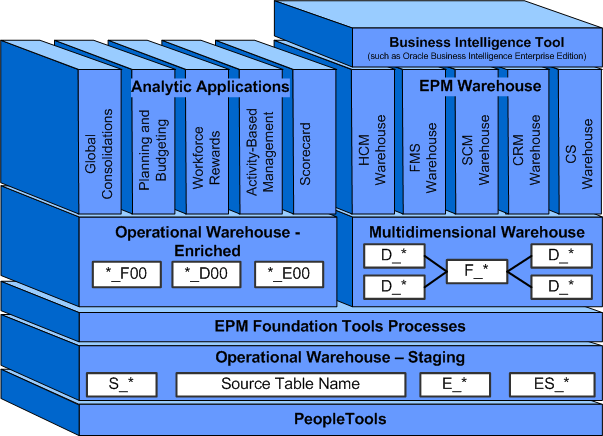PeopleSoft EPM Architecture
PeopleSoft EPM Warehouses and Analytical Applications are built on a foundation of specialized data warehouses, target warehouse tables, ETL jobs, metadata, and other prepackaged content that enable complex analysis and reporting of your data.
EPM target warehouse tables provide a way to consolidate and store your source transaction data. EPM target warehouse tables reside in two high-level data warehouse structures:
the Operational Warehouse (OW)
the Multidimensional Warehouse (MDW)
The Operational Warehouse can be further divided into the Operational Warehouse - Staging (OWS) and the Operational Warehouse - Enriched (OWE).
Each warehouse structure has its own set of specialized target warehouse tables that are unique to that structure. For example, the Operational Warehouse - Enriched (OWE) structure stores enriched data that is arranged in a normalized format to promote complex analytics. And the Multidimensional Warehouse (MDW) structure stores data that is arranged in a denormalized format (dimensional schema) for enhanced reporting capabilities.
Image: EPM architecture
The following graphic illustrates the various components comprising the EPM architecture and how each component relates to the others, including shared components which act as the foundation for both the EPM Warehouses and Analytical Applications.

The dual data warehouse architecture helps to:
Isolate and channel specific source data to the appropriate data warehouse structure for individual enrichment and modeling.
PeopleSoft provides extract, transform, and load (ETL) jobs to extract information contained in your source systems, load it into the Operational Warehouse - Staging (OWS) structure, and migrate that data to the Operational Warehouse - Enriched (OWE) and the Multidimensional Warehouse (MDW) structures. And because the warehouse structures are logically separated, the ETL jobs can isolate and channel specific source data to the OWE or the MDW.
Facilitate specialized, or tailored, data enrichment for your source data.
PeopleSoft provides EPM Foundation tools and processes (a set of specialized tools, processes, and metadata) that prepare and enrich your source data for the EPM Warehouses and Analytical Applications.
The delivered target warehouse tables, ETL jobs, Foundation tools, and other packaged content work together to provide the underlying infrastructure on which the EPM Warehouses and Analytical Applications are built. Detailed information regarding the OWS, OWE, MDW, and EPM Foundation tools can be found in this topic.
Note: EPM data warehouse structures refer to the OWS, OWE, and MDW, whereas EPM Warehouses refer to the PeopleSoft packaged warehouse solutions available for licensing, such as the Campus Solutions Warehouse and the Human Capital Management Warehouse.
Definition of a Data Warehouse
A textbook definition of a data warehouse is: a copy of transaction data specifically structured for query and analysis.
Transactional database applications have been widely used by the corporate world for over 30 years. Although data has been entered into dedicated transaction applications for decades, it has become apparent that extracting data from these systems for analytic purposes can be cumbersome and difficult.
Data warehousing is the process of taking data from legacy and transaction database systems and transforming it into organized information in a user-friendly format to encourage data analysis and support fact-based business decision-making.
A data warehouse is a central, integrated database that contains data from one or more operational sources and archive systems in an organization. It contains a copy of transaction data that is specifically structured for query analysis.
The mission of the data warehouse is to publish an organization's data assets to most effectively support decision-making. Because the data warehouse is a decision-support system, the main criterion of success is whether the data warehouse contributes to the most important decision-making processes in the organization.